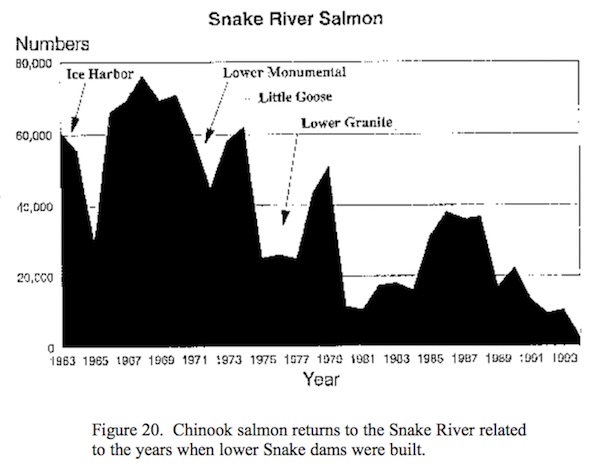forum
library
tutorial
contact

The Facts About Dams
by Roger RankinIdaho State Journal, February 26, 2021
|
the film forum library tutorial contact |

|
The Facts About Damsby Roger RankinIdaho State Journal, February 26, 2021 |
 Idaho Speaker of the House Scott Bedke's recent opinion column is alarmist. He has never studied the breaching of the four dams on the Lower Snake River in Washington, and his opinion is not accurate and not the message Idahoans need to hear.
Idaho Speaker of the House Scott Bedke's recent opinion column is alarmist. He has never studied the breaching of the four dams on the Lower Snake River in Washington, and his opinion is not accurate and not the message Idahoans need to hear.
I will challenge and address what he feels raises questions about Congressman Mike Simpson's plan for breaching the four dams and what it means to Idahoans.
I do not think dozens of cities will be "seriously affected by his proposal." What cities and how will they be seriously affected? Reality is this. The river communities from Lewiston to Stanley and Lewiston to Kooskia would enjoy an economic boom of majestic proportions. And the sales tax generated would be good for all Idaho citizens.
Congressman's proposal did not need to include anyone you mentioned. It stands on its own, backed by science and data. The organizations you mentioned had little to nothing to strengthen the proposal.
Mr. Bedke, the four dams generate 4 percent of BPA electricity. They have a 16 percent surplus. What you did not address is that millions have been spent to maintain the dams and guess who pays for it. And the BPA states it passes the costs to consumers of BPA electricity. Additionally, the BPA is going broke. The Bonneville Power Administration, the independent federal agency that sells the electricity produced by the dams, is careening toward a financial cliff. BPA is $15 billion in debt, facing a rapidly changing energy market increasingly dominated by wind and solar and a desperate need to maintain aging infrastructure that is expected to cost $300 million to maintain and upgrade by 2023.
While we all agree the dams, "river predators," in addition to the out migration, sport and commercial fishing, decline in the estuaries in the ocean and hot water take their toll. Of all these, the dams are the most detrimental to the fish, specifically the four dams on the Lower Snake River in Washington. We need to address the biggest problem, the critical problem. First.
Salmon and steelhead smolts used to get to the ocean in two weeks or less. That dynamic is changed by the four dams and can take weeks. And a high percentage of smolts do not reach the ocean. Smolts go down backwards on their journey to the sea. Lengthy, dead water lakes behind the dam do not offer the 2.6 mph flow they need. However, to some far-seeing individuals there is a "flush" yearly when smolts would be naturally to the ocean but the dams are still problematic.
A 4 percent return of Salmon and Steelhead would be all we would need to have a sustainable fishery in Idaho. I am disappointed, Mr. Bedke, that you did study the data relative to fish returns. We know that 7 percent of returning Salmon arrive at the first of the four dams. Less than 1 percent survive the trip through the four dams to come home to Idaho's crystal mountain streams. The data shows this is the greatest challenge returning fish face. As a result, Congressman Simpson's proposal is taking the biggest problem head on.
Mr. Bedke, your percentages of grain shipments from Lewiston are way off base. The use of barges is down to 17 percent and declining. That is because, in large measure, the grain growers have built a many-million-dollar facility to ship grain by rail. So the justification that Idaho cannot have a sustainable fishery because of moving grain is a pitiful excuse.
I really find it hard to believe that Congressman Simpson's hard work and subsequent proposal, based on data and science, would lead him to admit that he is not convinced that "breaching the four dams may not guarantee survival of the salmon" as you state. He may have stated that, I do not know, but the rest of us who know the facts will guarantee it will bring back our fishery. You might want to read the story of breaching dams on the Elwha River and how the fish returned to old spawning ground in big numbers and the fish rebounded.
Salmon at one time return to four lakes in Central Idaho and miles and miles of streams to spawn. They numbered 1 million before the dams were built on the Lowe Snake in the 1970s. Do you know who Lonesome Larry is?
Your article appears to be alarming and dramatic. Why don't you study the data, talk to individuals who have been involved with salmon decline and restoration, and get the real picture. Antiquated dams play a significant role in the future of our fish. They are facing extinction in the river system that produced the biggest salmon run in the world. Get on board. Know the data, statistics and impact of the four dams and then become a salmon advocate.
learn more on topics covered in the film
see the video
read the script
learn the songs
discussion forum
